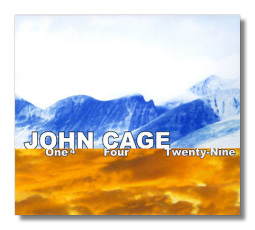
The Internet's Premier Classical Music Source
Related Links
- Cage Reviews
- Latest Reviews
- More Reviews
-
By Composer
-
Collections
DVD & Blu-ray
Books
Concert Reviews
Articles/Interviews
Software
Audio
Search Amazon
Recommended Links
Site News
 CD Review
CD Review
John Cage

Number Pieces
- One4
- Four (multiple versions)
- Twenty-nine
Christina Fong, violins/violas
Karen Krummel, cellos
Glenn Freeman, percussion
Michael Crawford, basses
OgreOgress UPC 643157342823 DDD 66:25
OgreOgress, a very "indie" label that has carved a niche for itself in the music of John Cage, continues its exploration of that composer's work with another disc of his so-called "number pieces." These pieces come from the end of his career when there was no fat left to strip away. One4 is not a mathematical statement, but rather an indication that this is the fourth piece in the series to be written for one performer – a drummer. Four requires, you guessed it, four performers. Twenty-nine is scored for 29 performers (in this performance, via overdubbing) and the work's playing time is 29 minutes.
According to OgreOgress, this is the first time that One4 and Twenty-nine have been recorded, and this also is "the first release to include all versions of Four." And therein lies another puzzle. Tracks 2-4 on this CD are labeled "Four A," "Four B," and "Four C," respectively, and each is five minutes long. Tracks 5-7 also are labeled "Four A," "Four B," and "Four C," respectively, and again, each is five minutes long. However, tracks 2 and 5 are not the same. Neither are tracks 3 and 6, nor are 4 and 7. Curious. Or rather, curious, until we understand that Cage never intended two performances of a given number piece to be the same; much has been left up to the discretion of the performer(s).
Also, we are advised that an alternate 30-minute version is "[tracks?] 5,6,7,2,3,4" (alternate to 2,3,4,5,6,7?), and that there is a 20-minute version ("2,4,5,7 or alternate 5,7,2,4") and a 10-minute version ("3,6 or alternate 6,3"). If you've been looking for a reason to use the programming functions on your CD player, look no further. But does it matter? That's really one of the central questions in much of Cage's output, and of course the answer is, "Yes it does, and no it doesn't."
Everything about an OgreOgress release is gently provocative. (No doubt Cage would have approved.) The "booklet notes" to this release are on the CD itself; I guess that is to prevent you from reading them while the CD is playing. But then again, they are printed parallel to the CD's "grooves," so you have to turn the disc by hand in order to read the notes. Even getting at the CD is a bit of a challenge. Eschewing a jewel box, OgreOgress has packaged the CD within folded cardstock, and the disc is held in place – is it ever! – by a tenacious plastic nipple. Clearly, the potential listener is meant to put labor into this experience from start to finish.
A few observations about the music are in order. Both Four and Twenty-nine impress me with their post-nuclear, nihilistic sadness, although I doubt that Cage would have thought much of that description. The writing in Twenty-nine is much more static and denser than in Four – one might even call it "industrial," given its droning qualities, and the expanded role played by percussion. (Much of Twenty-nine reminds me of Ligeti's earlier orchestral works – think of Atmosphères, but if it had been dipped in liquid nitrogen.) There even is an emotional climax of sorts in this work, in its 26th minute. At least that is how I heard it. One4 is more silence than sound, although of course all of it is music. The performances? Beyond criticism, I guess. The usual standards do not apply. I like the engineering, which brings the instruments up close while making the performance space seem big and empty.
The label's website is http://ogreogress.home-page.org, and purchasing information can be found there.
Copyright © 2005, Raymond Tuttle




















